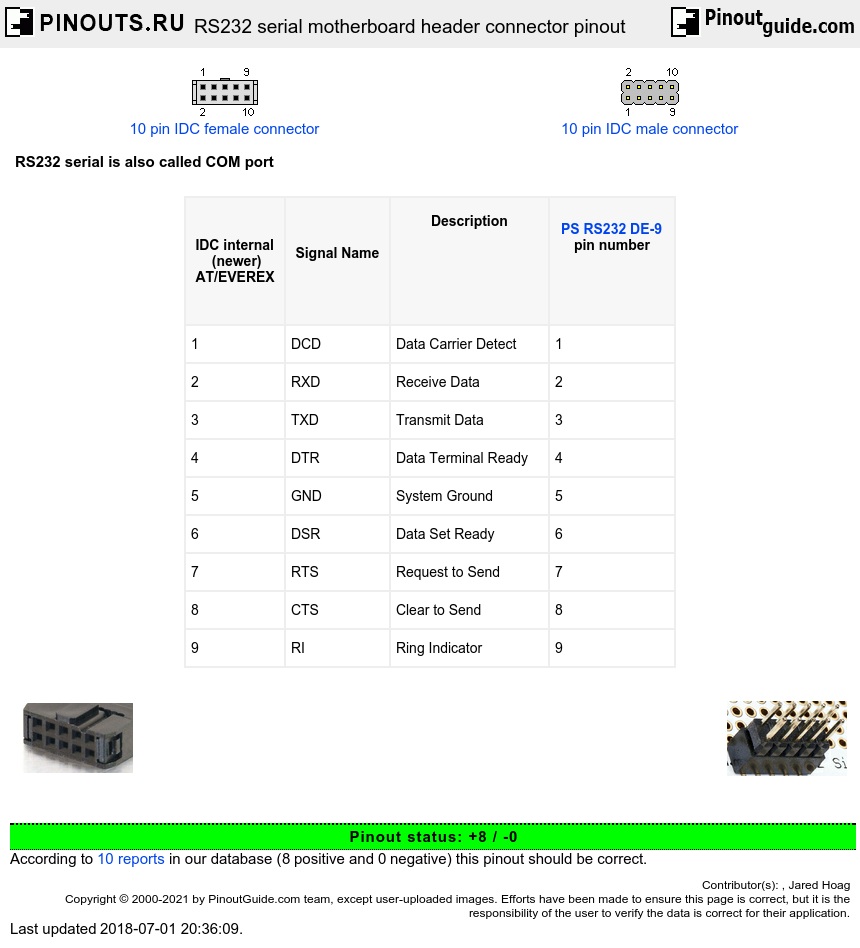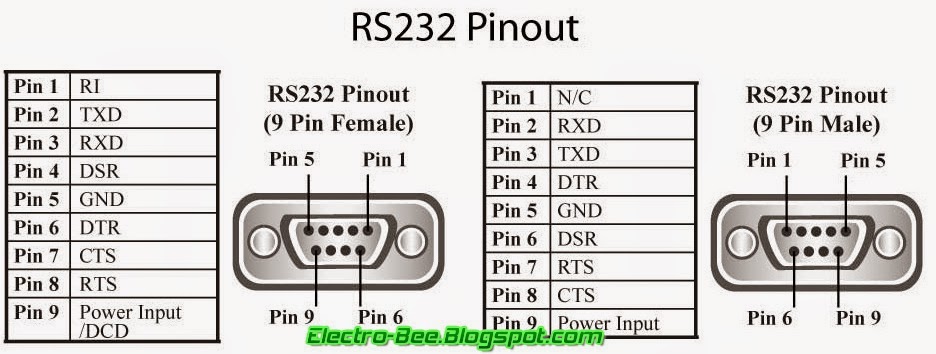Pinout of Epson Serial/RS-232 Cable DB9 to DB25 and layout of 9 pin D-SUB male connector and 25 pin D-SUB female connectorfor Epson Thermal/Impact Receipt Printer. 5 Pack Your Cable Store Serial Port 9 Pin Null Modem Adapter DB9 Male / Female RS232. The D-subminiature or D-sub is a common type of electrical connector. RS-422 Serial 9 pin 01 Mar 1998 9 pin D-SUB female connector. This connector is used on PCA-6773 motherboard and some other hardware.


RS232 Includes:
RS232 basicsRS232 standardSoftware handshakingSignals & voltage levelsPinouts & connectorsLoopback connectionsRS232 cables
Serial Data standards:Serial data standardsRS422RS449RS48520 mA current loop

The correct connection of the various pins used for an RS232 data link are key to the operation of the system.
Knowing the RS232 pinouts, or pin connections, and being able to make the required links enables the handshaking to operate correctly and the data to flow smoothly.
Rs232 9 Pin Connector
Although the RS232 standard does not define a connector, the 9 way and 25 way D-type connectors are very popular and provide an excellent format.
When using RS232, two main types of equipment are nominated. One is a data Terminal Equipment, DCE and the other is known as the Data Terminal Equipment, DTE. These abbreviations are widely used within RS232 and other communications terminology.

By using the pin outs as detailed below the RS232 cables used should be a 'one to one' configuration. This considerably simplifies the manufacture of RS232 cables and often means that standard cables can be used.
RS232 25 pin connections and functions
The RS232 (EIA-232-A) specification provides a full set of details for a wide variety of connections that can be used with RS232. While many of them are not normally known, they may be used in some circumstances and therefore the details are provided here for reference.
| RS232 25 pin signal definition for the DTE device - looking into the DTE connector DTE device is often a PC | |||
|---|---|---|---|
| DTE Pin No | Circuit name | Abbreviation | Source |
| 1 | Protective earth | ||
| 2 | Transmitted data | TXD | DTE |
| 3 | Received data | RXD | DCE |
| 4 | Request to send | RTS | DTE |
| 5 | Clear to send | CTS | DCE |
| 6 | Data set ready | DSR | DCE |
| 7 | Signal ground | ||
| 8 | Data carrier detect | DCD | DCE |
| 9 | Reserved for data set test | ||
| 10 | Reserved for data set test | ||
| 11 | Unassigned | ||
| 12 | Secondary received signal detector | DCE | |
| 13 | Secondary clear to send | DCE | |
| 14 | Secondary transmitted data | DTE | |
| 15 | Transmission signal element timing | DCE | |
| 16 | Secondary received data | DCE | |
| 17 | Receive signal element timing | DCE | |
| 18 | Unassigned | ||
| 19 | Secondary request to send | DTE | |
| 20 | Data terminal ready | DTR | DTE |
| 21 | Signal quality detector | DCE | |
| 22 | Ring indicator | DCE | |
| 23 | Data signal rate selector | DCE/DTR | |
| 24 | Transmit signal element timing | DTE | |
| 25 | Unassigned | ||
| RS232 25 pin signal definition for the DCE device - looking into the DCE connector DTE device is often a device such as a modem | |||
|---|---|---|---|
| DCE Pin No | Circuit name | Abbreviation | Source |
| 1 | Protective earth | ||
| 2 | Received data | RXD | DCE |
| 3 | Transmitted data | TXD | DTE |
| 4 | Clear to send | CTS | DCE |
| 5 | Request to send | RTS | DTE |
| 6 | Data set ready | DCE | |
| 7 | Signal ground | ||
| 8 | Data carrier detect | DCD | DCE |
| 9 | Reserved for data set test | ||
| 10 | Reserved for data set test | ||
| 11 | Unassigned | ||
| 12 | Secondary received signal detector | DCE | |
| 13 | Secondary request to send | DTE | |
| 14 | Secondary received data | DCE | |
| 15 | Transmission signal element timing | DCE | |
| 16 | Secondary transmitted data | DTE | |
| 17 | Receive signal element timing | DCE | |
| 18 | Unassigned | ||
| 19 | Secondary clear to send | DCE | |
| 20 | Data terminal ready | DTR | DTE |
| 21 | Signal quality detector | DCE | |
| 22 | Ring indicator | DCE | |
| 23 | Data signal rate selector | DCE/DTR | |
| 24 | Transmit signal element timing | DTE | |
| 25 | Unassigned | ||
By using these configurations it means that an RS232 cable connecting a DTE to a DCE will be wired in a one-to-one configuration, i.e. pin 1 to pin 1, etc.
RS232 9pin connections, functions and pin-outs
Although the RS232 25 pin configuration with a 25 way D-type connector is very widely used, in many applications the smaller 9 way D-type connector is used in many applications. It provides an obvious size and cost benefit. Also the RS232 9pin configuration is quite sufficient in most circumstances because many of the lines available for RS232 signalling are rarely used. This means that the 9 way connector is able to provide all the required connectivity for most applications.
9 Pin Serial Loopback Pinout
| RS232 9pin signal definition for the DTE device - looking into the DTE connector DTE RS232 device is often a PC. | |||
|---|---|---|---|
| Pin No | Circuit name | Abbreviation | Source |
| 1 | Received line signal detect | ||
| 2 | Receive data | RXD | |
| 3 | Transmit data | TXD | |
| 4 | Data terminal ready | DTR | |
| 5 | Signal ground | ||
| 6 | Data set ready | DSR | DCE |
| 7 | Request to send | RTS | |
| 8 | Clear to send | CTS | |
| 9 | Ring indicator | ||
| RS232 9pin signal definition for the DCE device - looking into the DCE connector DCE device is often a modem | |||
|---|---|---|---|
| Pin No | Circuit name | Abbreviation | Source |
| 1 | Received line signal detect | ||
| 2 | Transmit data | TXD | |
| 3 | Receive data | RXD | |
| 4 | Data terminal ready | DTR | |
| 5 | Signal ground | ||
| 6 | Data set ready | DSR | DCE |
| 7 | Clear to send | CTS | |
| 8 | Request to send | RTS | |
| 9 | Ring indicator | ||
By using these configurations it means that an RS232 cable connecting two RS232 devices, i.e. a DTE to a DCE will be wired in a one-to-one configuration, i.e. pin 1 to pin 1, etc.
When using RS232 it is essential to ensure that the correct connections are being used. It can be very difficult to fault-find when the wrong connections are made as nothing happens. Checking the voltages are correct and that the correct pins have been connected normally resolves the issues.
9 Pin Serial Port Pinout
Sometimes confusion can be caused by defining which is the DTE and which is the DCE. Once this has been correctly done, and the correct pins connected, the system should operate well.
9 Pin Serial Port Diagram
Wireless & Wired Connectivity Topics:
Mobile Communications basics2G GSM3G UMTS4G LTE5GWiFiIEEE 802.15.4DECT cordless phonesNFC- Near Field CommunicationNetworking fundamentalsWhat is the CloudEthernetSerial dataUSBSigFoxLoRaVoIPSDNNFVSD-WAN
Return to Wireless & Wired Connectivity
